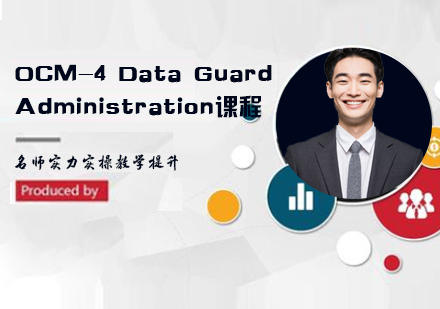课程详情
课程介绍
OCM-4 Data Guard Administration
对应:
Oracle OCM认证
培训课时:
12课时
课程介绍:
学员参加完OCMData Guard Administration课程培训后,可以掌握Data Guard技术,Data Guard是Oracle核心技术。搭建了Data Guard后可以实现数据库的灾备,有了灾备中心后,系统可以在高枕的运行。
适合人群:
OCMData Guard Administration培训适合先修完Oracle Database 10g:管理课程练习 I和Oracle Database 10g:管理课程练习 II这两门课程。
培训目标:
OCM培训Data Guard Administration培训目标:
1、Use Data Guard to achieve a highly available Oracle Database
2、Describe the Data Guard architecture
3、Modify the Data Guard services
4、Use the Data Guard broker
5、Implement physical and logical standby databases
6、Perform failover and switchover operations
7、Enable fast-start failover
1、Use Data Guard to achieve a highly available Oracle Database
2、Describe the Data Guard architecture
3、Modify the Data Guard services
4、Use the Data Guard broker
5、Implement physical and logical standby databases
6、Perform failover and switchover operations
7、Enable fast-start failover
课程大纲:
OCM培训Data Guard Administration课程大纲:
章. Oracle Data Guard: Overview
1.1. What Is Oracle Data Guard?
1.2. Types of Standby Databases
1.3. Data Guard Broker Framework
1.4. Types of Services
1.5. Benefits of Implementing Oracle Data Guard
第二章. Understanding the Oracle Data Guard Architecture
2.1. Oracle Data Guard Architecture
2.2. Data Guard Redo Apply Architecture
2.3. Data Guard SQL Apply Architecture
2.4. Specifying Role-based Destinations
2.5. Configuring Standby Redo Logs
2.6. Standby Database Modes
第三章. Using Oracle Data Guard Broker and Enterprise Manager
3.1. Oracle Data Guard Broker Features
3.2. Data Guard Broker Configurations
3.3. Benefits of Using the Data Guard Broker
3.4. Data Guard Broker Interfaces
3.5. Using Enterprise Manager 10g Grid Control
第四章. Creating a Configuration and Physical Standby Database by Using Enterprise Manager
4.1. Using Enterprise Manager to Create a Broker Configuration
4.2. Using the Add Standby Database Wizard
4.3. Creating a Physical Standby Database
4.4. Verifying a Configuration
4.5. Creating Standby Redo Logs
4.6. Viewing the Data Guard Configuration Status
4.7. Viewing Data Guard Performance
第五章. Creating a Physical Standby Database by Using SQL
5.1. Preparing the Primary Database
5.2. Setting Initialization Parameters on the Primary Database
5.3. Backing Up the Primary Database Using RMAN
5.4. Creating a Control File for the Standby Database
5.5. Setting Initialization Parameters on the Standby Database
5.6. Setting Up the Environment to Support the Standby Database
5.7. Starting the Physical Standby Database
5.8. Performing Additional Configuration Tasks
第六章. Configuring Data Protection Modes and Log Transport Services
6.1. Setting the Log Transport Mode
6.2. Setting the Data Protection Mode
6.3. Delaying the Application of Redo
6.4. Using Flashback Database as an Alternative to Apply Delay
6.5. Additional Attributes that Affect Log Transport Services
第七章. Creating a Logical Standby Database by Using Enterprise Manager
7.1. Benefits of Implementing a Logical Standby Database
7.2. Preparing to Create a Logical Standby Database
7.3. Checking for Unsupported Objects and Data Types
7.4. Enabling Supplemental Logging
7.5. Creating a Logical Standby Database by using Enterprise Manager
7.6. Using the Add Standby Database Wizard
7.7. Enabling and Disabling the Auto-Delete Feature
第八章. Creating a Logical Standby Database by Using SQL
8.1. Preparing to Create a Logical Standby Database
8.2. Creating a Physical Standby Database
8.3. Preparing the Primary Database
8.4. Transitioning to a Logical Standby Database
8.5. Opening the Logical Standby Database
8.6. Verifying the Logical Standby Database
8.7. Performing Additional Configuration Tasks
第九章. Performing Switchover and Failover
9.1. Choosing the Best Role Transition Operation
9.2. Performing a Switchover by Using Enterprise Manager
9.3. Performing a Switchover by Using SQL
9.4. Performing a Failover by Using Enterprise Manager
9.5. Performing a Failover by Using SQL
9.6. Restoring Databases After a Role Transition
9.7. Flashback Through Standby Database Role Transitions
第十章. Enabling Fast-Start Failover
10.1. When Will Fast-Start Failover Occur?
10.2. Configuring Fast-Start Failover
10.3. Prohibited Operations After Enabling Fast-Start Failover
10.4. Managing the Observer
10.5. Performing Role Changes
10.6. Using Enterprise Manager to Enable Fast-Start Failover
第十一章. Using Data Guard in a Real Application Clusters Configuration
11.1. Real Application Clusters and Data Guard
11.2. Configuration Considerations with RAC
11.3. Configuring a Primary Database with RAC
11.4. Configuring a Standby Database with RAC
11.5. Apply Instance Failover
11.6. Role Transitions with RAC
第十二章. Other Considerations for Oracle Data Guard
12.1. Using a Physical Standby Database for Read/Write Testing and Reporting
12.2. Offloading Backups to a Physical Standby Database
12.3. Using Flashback Database and Real-time Apply
12.4. Using Flashback Database After RESETLOGS
12.5. Enabling Redo Encryption
12.6. Configuring Cascaded Redo Log Destinations
第十三章. Workshop
13.1. Workshop Premise
13.2. Workshop Flow
13.3. Wo
1.1. What Is Oracle Data Guard?
1.2. Types of Standby Databases
1.3. Data Guard Broker Framework
1.4. Types of Services
1.5. Benefits of Implementing Oracle Data Guard
第二章. Understanding the Oracle Data Guard Architecture
2.1. Oracle Data Guard Architecture
2.2. Data Guard Redo Apply Architecture
2.3. Data Guard SQL Apply Architecture
2.4. Specifying Role-based Destinations
2.5. Configuring Standby Redo Logs
2.6. Standby Database Modes
第三章. Using Oracle Data Guard Broker and Enterprise Manager
3.1. Oracle Data Guard Broker Features
3.2. Data Guard Broker Configurations
3.3. Benefits of Using the Data Guard Broker
3.4. Data Guard Broker Interfaces
3.5. Using Enterprise Manager 10g Grid Control
第四章. Creating a Configuration and Physical Standby Database by Using Enterprise Manager
4.1. Using Enterprise Manager to Create a Broker Configuration
4.2. Using the Add Standby Database Wizard
4.3. Creating a Physical Standby Database
4.4. Verifying a Configuration
4.5. Creating Standby Redo Logs
4.6. Viewing the Data Guard Configuration Status
4.7. Viewing Data Guard Performance
第五章. Creating a Physical Standby Database by Using SQL
5.1. Preparing the Primary Database
5.2. Setting Initialization Parameters on the Primary Database
5.3. Backing Up the Primary Database Using RMAN
5.4. Creating a Control File for the Standby Database
5.5. Setting Initialization Parameters on the Standby Database
5.6. Setting Up the Environment to Support the Standby Database
5.7. Starting the Physical Standby Database
5.8. Performing Additional Configuration Tasks
第六章. Configuring Data Protection Modes and Log Transport Services
6.1. Setting the Log Transport Mode
6.2. Setting the Data Protection Mode
6.3. Delaying the Application of Redo
6.4. Using Flashback Database as an Alternative to Apply Delay
6.5. Additional Attributes that Affect Log Transport Services
第七章. Creating a Logical Standby Database by Using Enterprise Manager
7.1. Benefits of Implementing a Logical Standby Database
7.2. Preparing to Create a Logical Standby Database
7.3. Checking for Unsupported Objects and Data Types
7.4. Enabling Supplemental Logging
7.5. Creating a Logical Standby Database by using Enterprise Manager
7.6. Using the Add Standby Database Wizard
7.7. Enabling and Disabling the Auto-Delete Feature
第八章. Creating a Logical Standby Database by Using SQL
8.1. Preparing to Create a Logical Standby Database
8.2. Creating a Physical Standby Database
8.3. Preparing the Primary Database
8.4. Transitioning to a Logical Standby Database
8.5. Opening the Logical Standby Database
8.6. Verifying the Logical Standby Database
8.7. Performing Additional Configuration Tasks
第九章. Performing Switchover and Failover
9.1. Choosing the Best Role Transition Operation
9.2. Performing a Switchover by Using Enterprise Manager
9.3. Performing a Switchover by Using SQL
9.4. Performing a Failover by Using Enterprise Manager
9.5. Performing a Failover by Using SQL
9.6. Restoring Databases After a Role Transition
9.7. Flashback Through Standby Database Role Transitions
第十章. Enabling Fast-Start Failover
10.1. When Will Fast-Start Failover Occur?
10.2. Configuring Fast-Start Failover
10.3. Prohibited Operations After Enabling Fast-Start Failover
10.4. Managing the Observer
10.5. Performing Role Changes
10.6. Using Enterprise Manager to Enable Fast-Start Failover
第十一章. Using Data Guard in a Real Application Clusters Configuration
11.1. Real Application Clusters and Data Guard
11.2. Configuration Considerations with RAC
11.3. Configuring a Primary Database with RAC
11.4. Configuring a Standby Database with RAC
11.5. Apply Instance Failover
11.6. Role Transitions with RAC
第十二章. Other Considerations for Oracle Data Guard
12.1. Using a Physical Standby Database for Read/Write Testing and Reporting
12.2. Offloading Backups to a Physical Standby Database
12.3. Using Flashback Database and Real-time Apply
12.4. Using Flashback Database After RESETLOGS
12.5. Enabling Redo Encryption
12.6. Configuring Cascaded Redo Log Destinations
第十三章. Workshop
13.1. Workshop Premise
13.2. Workshop Flow
13.3. Wo
课程评价
聚划算








